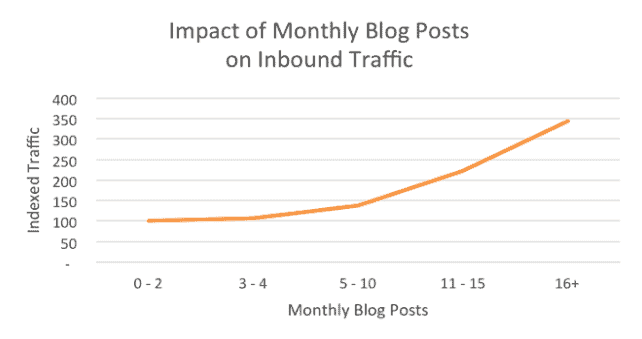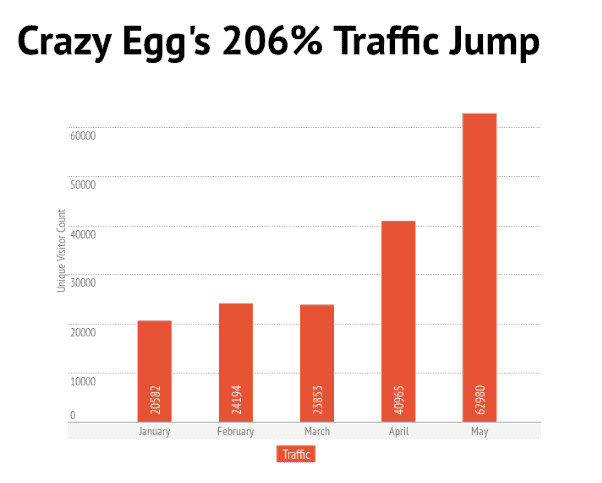Okay, okay, we know. 2587%?! Where on earth did that number come from? And how in the world can it be possible to boost blog traffic by such a ridiculous percentage?
We’re sure you’ve seen the posts from marketing gurus across the web… How I increased my blog traffic by X%…. How our company boosted blog traffic by X visitors per month in only X days…
So what we here at Zen Media have done is simply put together a list of those marketing gurus’ secrets and advice, so that you can find them all in one place, and put them all to use in driving traffic to your own business blog. Using a super-scientific formula and a little pixie dust, we added up all the numbers from each guru, and voila! 2587%!
Using a super-scientific formula and a little pixie dust, you can boost blog traffic by 2587%! Click To TweetHere’s the thing. Blogs are the cornerstone of a company’s content marketing strategy. Each blog post that you’re able to create and publish is another mechanism that will help draw in both current and prospective customers.
For small and medium sized companies, blogging might seem like an unnecessary part of running a business. On top of all of the other operational activities, business owners might be hard-pressed to find the time that’s necessary to maintain an effective blog. Where should you start? What should be the tone of your articles? What topics would you even write about?
If you’re still on the fence regarding the importance of blogging, continue reading to learn about the benefits of what you could gain by allocating just a few hours a week to your blog.
The Benefits of Blogging
There is no disputing the difference that blogging and content creation can make in terms of visibility, sales and leads – and the benefits don’t stop there! From relationship building to SEO benefits, there are many things to be gained by dedicating yourself to maintaining a company blog.
1. Increase marketing ROI
Blogging is proven to increase your bottom line – something that every business is aiming to achieve! In fact, a 2015 Hubspot report found that companies that blog are 13x more likely to generate a positive marketing ROI. Thirteen times! Blog posts increase the number of inbound links to your site, which increases the chance that prospective customers will find you – and buy.
2. Create a connection with your customers
Sure, you’re a business. By nature, this means that you, as the business owner, are often pushing information out to your audience about the products you have available, promotions you are running, and any other information relevant to your industry that you feel your customers could benefit from. And a blog is a great place to do this.
But a blog can also serve as a platform for creating a deeper relationship with your audience. By sharing more personal stories about your team, your company culture, your customers, or even yourself, you can give your audience an insider peek into the stories of the real people behind the company. Building that kind of emotional, personal connection makes an audience more likely to become customers, more likely to remain loyal, and more likely to become brand advocates.
3. Stay fresh
Fresh and updated content is a major factor in driving traffic to your site. A blog with a high volume of continuously generated new content will not only create more leads for your business, but will also keep your website in a good position on Google. Google loves to see new content and rewards sites with increased visibility as a result of this.

http://blog.hubspot.com/marketing/blogging-increases-traffic
If you’re just getting started with your blog, try to start with at least one post per week and slowly work your way up as you become more comfortable with generating topics and content. Every time you create a new blog post, it’s one more indexed page on your website, which will drive traffic and improve your company’s ranking on Google. In addition, by making a commitment to creating new content, you can take advantage of current and seasonal events, which will also increase your exposure to trending searches on Google, as well as social media platforms.
4. Position yourself as an expert
With every new post you write, you are building credibility for yourself and your business as an expert in the industry. Creating high-quality content means keeping customers informed about the tried and true in your field, along with the latest new technologies and techniques – as well as sharing your thoughts on what is currently going on in your industry. Writing blog posts that are informative and truly helpful for your customers helps to carve out your position as an expert and trusted go-to source in your industry.
Increase traffic to your blog
Now that we’ve seen the benefits that can be gained by maintaining a company blog, let’s take a look at the techniques that leading marketing gurus live by when working to increase traffic.
Derek Halpern – A guide to increase your traffic by 69%

As one of the leaders in the marketing industry, Derek Halpern is recognized as a guru in the area of generating traffic and helping people turn that web traffic into leads and sales.
Over the years, he has developed a 3-step formula for propelling a blog’s growth to increase both raw traffic and loyal customer traffic. In January 2012, Derek launched his first podcast and saw an increase of 69% in traffic in one month! Since this successful month over month growth, he has perfected his formula to launch anything (podcast, webinar, etc.) to increase traffic to your blog. Let’s break down this 3-step formula and how you can implement it to get a head start on increasing your blog’s traffic!
Step 1: Discover Your Unique Selling Proposition
Regardless of whether you want to launch a blog, podcast or webinar series, you need to create something that fills a need within the market and provides a solution that doesn’t exist elsewhere. In short, you need to define how you will be different from the other blogs, podcasts, webinar series, etc. that are already active.
In order to understand how you can differentiate yourself, you need to know what’s already out there. Take a look at your top two or three competitors and figure out the topics they tend to cover, the market they are trying to target and the portfolio of products/services that they offer. Write down the answers to each of these questions for each of your main competitors to define their “personality” as a business.
Based on what competitors are doing, you can create a unique recipe for your own product/service by combining together a unique combination of criteria that is only covered by you. Even if you have similar blog topics to a competitor of yours, you can still create uniqueness for your blog by catering to a different target market or by offering something, like a podcast, that your competitor doesn’t provide.
The key here is that creating an effective launch is not about reinventing the wheel, but rather about finding the “unique recipe” that works for you!
Step 2: Build Anticipation the Right Way
The greatest opportunity in launching something new is the ability to build anticipation for its launch. According to Derek Halpern, this is a MUST when it comes to the release of something new. Why is this so important?
To start, the anticipation that you build around the launch will get people talking about your company. It will drive them to say things like, “I can’t wait for your new webinar!” or “I’m so excited to see what you come up with next!” They will be actively checking in on your blog for announcements, clicking links in emails that you send them and, overall, be more engaged with your brand. In order to fully maximize on these benefits and increased engagement, you need to draw out the anticipation for longer than one day.
The biggest mistake businesses make when building anticipation is to announce and launch the product on the same day. People are intrigued by the fact that something new is coming and they don’t know what it is. Building anticipation should be looked at in two, separate steps: the announcement and the release. The announcement will pique interest and the release will sell them on the quality of the products and services that your business is offering. By separating these two steps over the course of a few days or weeks, you can build maximum anticipation.
Step 3: Follow Through on Your Promises
You have designed a unique product or service that you’re sure will attract customers. You’ve built up the anticipation and increased engagement among your subscribers and readers. Now, it’s time for the final step: to deliver on the content that you’ve promised.
According to Derek, a great way to ensure that you’ve met the expectations of your customers is to over deliver by adding an unannounced bonus or a beautifully designed product. For example, if you announce that you will be launching a webinar, you can over deliver by launching that webinar and accompanying it with a transcript and an audio version that can be listened to on-the-go.
Neil Patel – How to Increase your traffic by 206%

The next marketing guru that we want to cover is Neil Patel, the creator of Crazy Egg. As one of the leading voices in the marketing world, he is a trusted source for companies of all sizes regarding topics including revenue generation and increasing blog traffic.
We’ve scoured some of Neil Patel’s top articles for increasing traffic to find his tips for how to drive traffic to your blog:

http://neilpatel.com/2014/09/30/7-proven-strategies-to-increase-your-blogs-traffic-by-20
1) Quantity, Quantity and more Quantity
For new bloggers, one piece of content per week is a huge step up from no content at all. As you develop your blog, you should plan to increase the frequency of posting updated content to 2, 3, 4 or even 5 pieces per week. Each additional blog post can increase your overall blog traffic by about 18.6%, which will help you to increase both new and returning readers to your page. It is important, however, not to write such a high quantity of articles that the quality begins to suffer. Both Google and your readers will penalize you for poor quality posts, and your traffic will drop accordingly.
2) Eye-catching headlines
Headlines are the first part of your content that a reader sees. They might see it directly on your blog, or wherever you are promoting it, whether it is on social media, in an email, or on a search engine. Neil Patel agrees with the passionately held belief of MZ’s own content department that it is more effective to write headlines that appeal to both people and search engines, not one or the other. While it may take a few months to see all the positive effects of this strategy, it is simple to implement and will drive traffic to your page within 6 months or less.
3) Collect emails from your readers
Email is one of the largest sources of traffic for websites. Why? Emails contain easy to click links that bring them directly to a page of interest. There is no need for them to browse around or get lost on your page, but rather, they get the updates and information they want delivered directly to their inbox. In order for you to send them these emails promoting your newest content, you need to set up ways to collect their email addresses, such as pop-ups offering free downloads for opt-ins.
4) Infographics
While it may require a high quantity of written articles to increase traffic on your blog, infographics are one of the more efficient techniques that are particularly useful for small and medium businesses. In less than two years, Neil Patel was able to generate more than 2 million visitors on the KISSmetrics page from just 47 infographics. Check out his guide to creating infographics if you want to get started making your own!
Jon Morrow – Boosting blog traffic is what his business is all about

Jon Morrow is one of the most well recognized names in marketing and the creator of BoostBlogTraffic.com (recently rebranded to SmartBlogger.com as of March 2016). He got his start by blogging about how to increase traffic to your blog, so it’s safe to say that the following tips have been defined through experience and by a true expert in the field. According to Job Morrow, the following points are some of the most important things to keep in mind in order to generate traffic:
Headlines:
Jon Morrow himself spends about two hours crafting the perfect headline to accompany each blog post – two hours! His general rule is that you should spend about one quarter to one half of the time that you spend writing your full post on crafting just the headline. A title should not be treated as an afterthought. For Jon Morrow, headlines, and content in general, circle back to showing readers how they can be “more interesting.”
“How to” posts:
He sees these “how to” posts as the key to driving traffic. They serve as click bait and really work to successfully drive traffic to your site. These types of posts should make up the bulk of information on your blog, as they serve to inform and help readers learn how to “be more interesting” in the same way that his headlines promise.
Bonding posts:
The goal of these posts is to connect with the audience. While they drive less traffic than the “How to” posts, they usually receive more comments and engagement from readers. Bonding posts should still be related back to a specific topic of interest, but allow you as the writer to bond with the audience by providing information about yourself or an emotional story from your life. These posts should be used more intermittently than the “How to” posts, but remain an important part of an overall blogging strategy and a tool to drive traffic.
Gotta Blog!
After hearing the tips and tricks from these marketing gurus, it’s a no-brainer that blogging is a MUST for all businesses. For those just getting started, remember to create as much high quality content as possible, well thought out headlines that appeal to both search engines and people and, finally, remember to build anticipation around the release of your newest products and services. By following these principles, you will be well on your way to increasing traffic on your site by at least 2587%!
If you don’t have to time to dedicate to getting your blog up and running, contact us at Zen Media, so we can help you ensure that you are on the right track to meeting your blogging goals!







